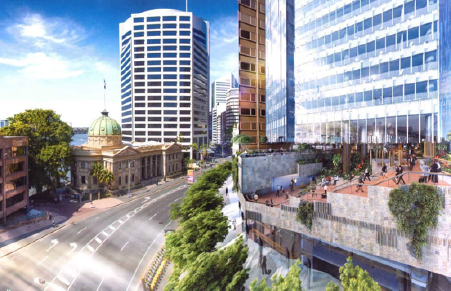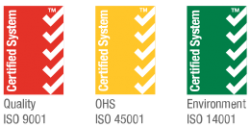Steel Australia: 480 Queen Street, Brisbane; Faster floors allow earlier occupancy
Steel Australia: Addressing tall order for speedier safer construction
480 Queen Street, Brisbane
A steel-intensive approach has allowed an innovative parallel beam flooring system to further speed construction of the new 480 Queen Street office tower allowing a new floor to be added each week along with the more traditional benefits derived from using offsite fabrication alleviating onsite congestion, providing better safety and logistical efficiencies.
The building is targeted to be the only premium grade, 6-star Green Star rated tower of the three new office towers currently under development in Brisbane. It comprises approximately 4000 tonnes of steel made up of approximately 2500 tonnes of universal sections, 500 tonnes of fabricated beams and 1000 tonnes of tubular columns.
Associate, Buildings project engineer at Aurecon, Aaron Toscan said this is the first steel building of this size in Brisbane. It also utilises a steel system that has never been used here before on a building of such large scale.
He said that the floor construction uses parallel continuous primary floor beams with continuous secondary beams above supporting a steel formwork supported concrete slab.
“Given the multiple layers of structure, particular attention has to be paid to diaphragm action to transfer column restraint actions as well as wind and earthquake loads to the lateral resisting core;’ he said.
He said for the parallel beam flooring system, beams are placed in two separate layers like a bearer and joist arrangement allowing all building services to ‘weave’ in and out with zero beam penetrations.
“By eliminating beam penetrations the control of fire spray coverage is also simplified both during and after construction.The approach allows construction to speed up from fabrication to installation with every process significantly quicker:’ Assistant Project Manager at Grocon, Cameron Starkey said cycle times for the three zones which make up the 3355sqm campus floor plates (floors 6 to 14) are achieving five day turnarounds.
“Although comparable to conventional concrete cycle times, material time benefit is realised by eliminating formwork support frames and back propping allowing services and finishes trades onto the open decks sooner than conventional construction methods,” he said. “While steel construction is delivering time benefits, it is also proving to be a safer method of construction with no Lost Time Injuries (LTIs) occurring on the project to date which is particularly pleasing for Grocon as safety is a core value for our company.
“This improved safety can be attributed to the mecca no style installation method, simplified structural connections and significantly reduced formwork back-propping.”
Engineering Manager at the project’s prime steelwork contractor and ASI fabricator, Pacific Industrial Company (PIC), Peter Burns said that the simplicity of the framing approach means that only 10 percent of the floor beams were undergoing fabrication work.
“The system and connections allow a high rate of steel installation with steel framing for a 1000sqm area of floor taking only two days to erect and only a further single working day for the laying of the Fielders RF55 steel decking,” he said.
“This approach has not only reduced the need for penetrations in beams but has also freed up building services for a lot more flexibility, both during current construction and into the future,” MrToscan said.
“The continuous primary and secondary beam arrays use smaller beams compared with a simply supported design which in turn means less steel tonnage and also enables us to create far simpler steel connections.
“Beams can be connected more efficiently as secondary beams need only be rested and connected in bearing with a couple of bolts leading to a significant reduction in crane time. Shear studs were only used sparingly, rather than abundantly as for an alternative composite design.”
He said the parallel beam system has been employed overseas, particularly in the UK and US and technically and conceptually applied to the design of buildings in Australia such as the Brisbane International Terminal, but not for a capacity as in the Queen Street tower.
Apart from lowering onsite safety risks, PIC was able to employ climbing screens at floor edges to enhance safety at height.
“The use of our in-house designed safety screen system has been a major advantage for PIC on the project. We are able to tailor the system for each project and are now finding significant labour efficiencies in the repetitive climbing of the screens,” Mr Burns said.
“Installation commences with pre-assembled handrail units bolted to permanent edge beams with the climbing screen system installed after completion of three or four consecutive floors.”
The use of steelwork that is delivered to site is controlled by one subcontractor. Whilst there is still a crane being operated onsite it is generally a simple straightforward process to operate and manage in the hustle and bustle of inner Brisbane.
Key steel supplier on the project, OneSteel provided a processing and delivery offer to cut and drill all long product and plate materials required for the project.
Business Development Manager, Queensland at OneSteel Metalcentre, Frank Van De Weyer said approximately 2500 tonnes has been processed in Brisbane, individually marked and made ready for loading for transportation to site.
“Material is pre-ordered from mill rolling to reduce waste and enable efficient nesting with delivery to site to match the specific order defined by the site erection methodology,” he said.
“Stillages are preloading for efficient site crane utilisation allowing for just one unloading movement per stillage.”
As the project is primarily only using one type of framing material in steel, the site is very clean and tidy compared with the site of a conventional concrete framed building which is difficult to maintain when a lot of different formwork is being delivered and stored onsite.
Grocon engaged detailers to co-locate with Aurecon in their Brisbane office to collaborate and produce a well coordinated 3D model in order to mitigate possible coordination issues later onsite.
Mr Starkey commented that whilst there are big positives with steel construction, there are still a number of factors that need to be addressed to ensure it is utilised to its full potential.
“Multilevel constructing being so crane-reliant means adequate craneage is required to complete the works while allowing crane time to service other trades,” he said.
To help address this, Grocon is using alternative lifting devices for certain components like the self-climbing perimeter screens as well as reduced material component sizes to allow loading via hoists and after hours.
Grocon has been working with PIC and their self-climbing perimeter screen design to ensure all edges are adequately protected during and post concrete pour activities as the edge gap requires a different approach to conventional formwork.
Mr Starkey also noted the large lead times involved with structural steel including design, shop drawing, procurement, fabrication, delivery and installation.
“Design needs to be finalised in time to accommodate lead times without affecting the required installation dates,” he said. “The knowledge learnt from this build will add to the experience already obtained from previous structural steel buildings created to ensure that Grocon is and continues to be an industry leader when it comes to structural steel construction.”
Steel Australia — December 2014
Back to News


